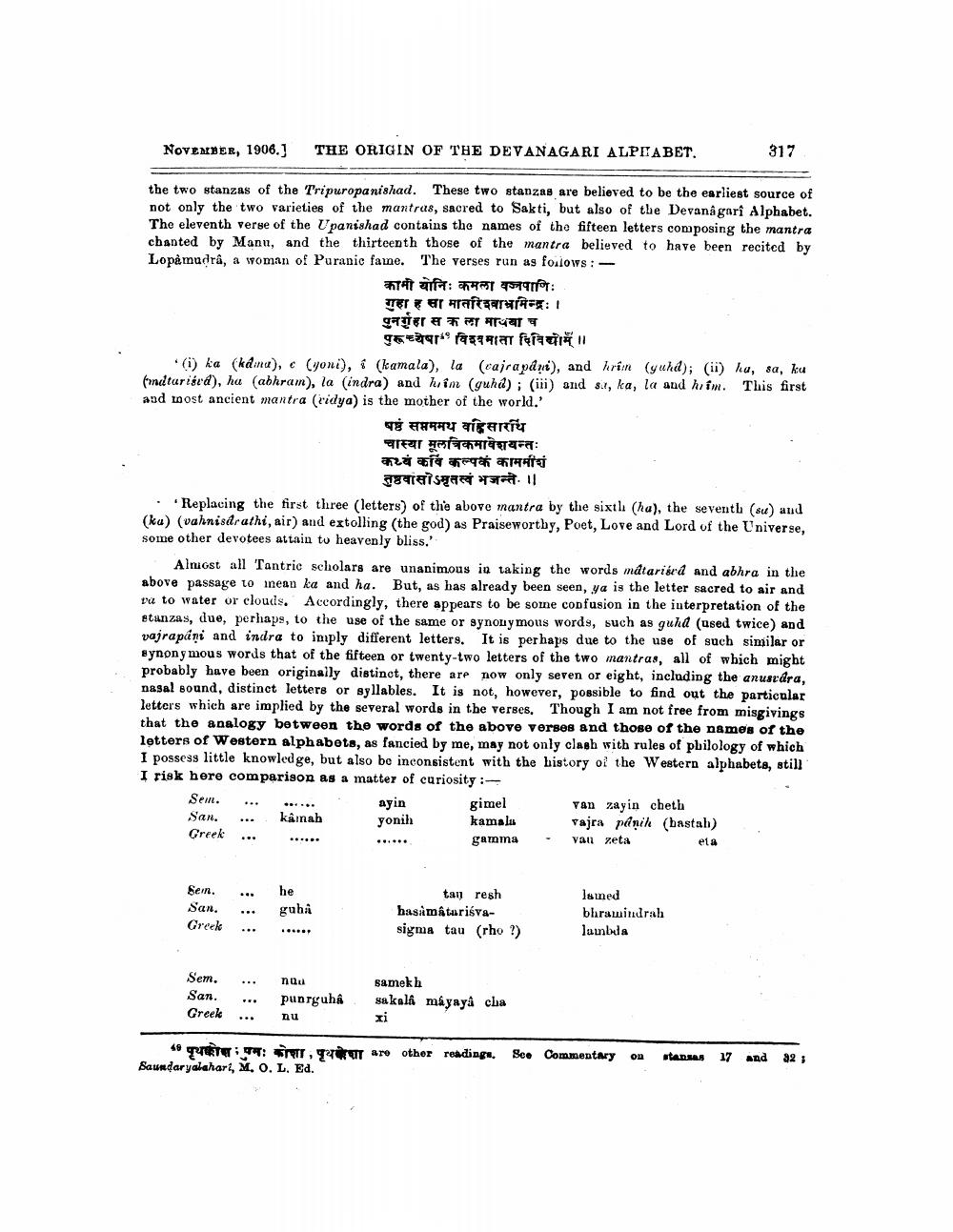________________
NOVEMBER, 1906.)
THE ORIGIN OF THE DEVANAGARI ALPIYABET.
317
the two stanzas of the Tripuropanishad. These two stanzas are believed to be the earliest source of not only the two varieties of the mantrus, sacred to Sakti, but also of the Devanagari Alphabet. The eleventh verge of the Upanishad contains the names of the fifteen letters composing the mantra cbanted by Manu, and the thirteenth those of the mantra believed to have been recited by Lopamudra, a woman of Puranic fame. The verses run as foulows:
कामी योनिः कमला वजपाणिः . गुहा हसा मातरिश्वाभ्रमिन्द्रः । पुनर्गहा स कला मायया ष
पुरूच्येषा" विश्वमाता विवियोम् ।। . (i) ka (kdina), < (yoni), i (kamala), la (cajrapani), and hrin (yuhd); (ii) ha, sa, ku rundturisd), ha (abhram), la indra) and hiim (guhd); (iii) and 8.1, ka, la and him. This first and most ancient mantra (ridya) is the mother of the world.'
षष्ठं सप्तममय वहिसारथि चास्या मूलत्रिकमावेशयन्तः कथ्य कवि कल्पक काममीशं
तष्ठवासोऽमृतत्वं भजन्ते ।। · Replacing the first three (letters) of the above mantra by the sixtli (ha), the seventh (su) and (ku) (vahnisdrathi, air) and extolling (the god) as Praiseworthy, Poet, Love and Lord of the Universe, some other devotees attain to heavenly bliss.'
Almost all Tantric scholars are unanimous in taking the words mdtarigrd and abhra in the above passage to unean ka and ha. But, as has already been seen, ya is the letter sacred to air and vu to water or clouds. Accordingly, there appears to be some confusion in the interpretation of the stanzas, due, perhaps, to the use of the same or synonymous words, such as guhd (used twice) and vajrapani and indra to imply different letters. It is perhaps due to the use of such similar or synonymous words that of the fifteen or twenty-two letters of the two mantras, all of which might probably have been originally distinct, there are now only seven or eight, including the anustára, nasal sound, distinct letters or syllables. It is not, however, possible to find out the particular letters which are implied by the several words in the verses. Though I am not free from misgivings that the analogy between the words of the above verses and those of the names of the letters of Western alphabets, as fancied by me, may not only clash with rules of philology of which I possess little knowledge, but also be inconsistent with the history of the Western alphabets, still I risk hero comparison as a matter of curiosity :
ayin gimel van zayin cheth San. .. kamah
kamalu vajra pánik (bastah) Greek ... .....
gamma - van zeta
Seilt.
...
yonih
eta
he
Sein. San. Greek
... ... ...
guba
tan resh hasimaturiśvasigma tau (rho?)
lained bhrawindrah lambda
Sem. San. Greek
... ... ...
nuu punguha nu
Samekh sakali mayaya cha
40 TARTOTT: M , T Saundaryalahari, M. O. L. Ed.
OT are other reading.
See Commentary
on
an AS
17
and
12 ;




